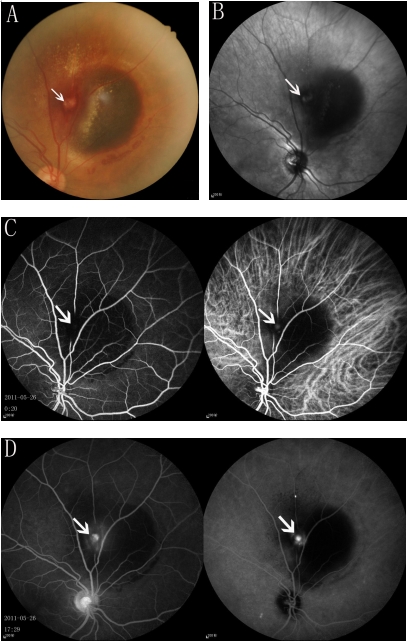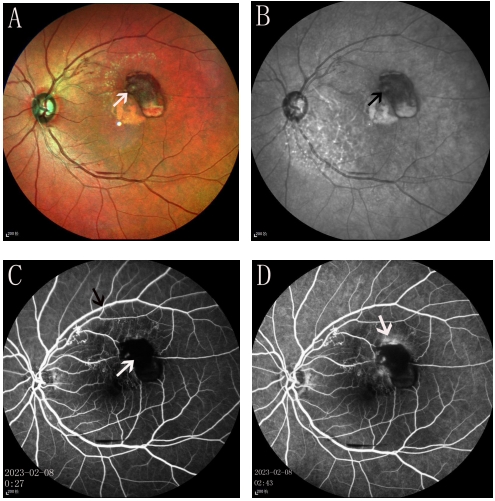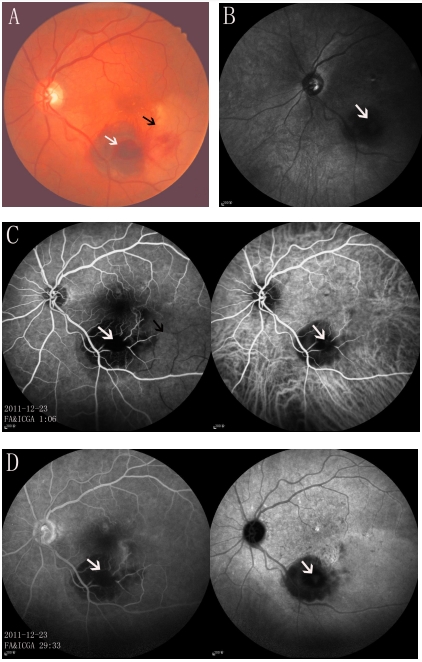1、Nyman N. Retinal arterial macroaneurysms[ J]. J Am Optom Assoc,
1989, 60(1): 45-47Nyman N. Retinal arterial macroaneurysms[ J]. J Am Optom Assoc,
1989, 60(1): 45-47
2、Pitk%C3%A4nen%20L%2C%20Tommila%20P%2C%20Kaarniranta%20K%20%2C%20et%20al.Retinal%20arterial%20%0Amacroaneurysms%5B%20J%5D.%20Acta%20Ophthalmol%2C%202014%EF%BC%8C92(2)%3A101-104.%20DOI%3A%20%0A10.1111%2Faos.12210.Pitk%C3%A4nen%20L%2C%20Tommila%20P%2C%20Kaarniranta%20K%20%2C%20et%20al.Retinal%20arterial%20%0Amacroaneurysms%5B%20J%5D.%20Acta%20Ophthalmol%2C%202014%EF%BC%8C92(2)%3A101-104.%20DOI%3A%20%0A10.1111%2Faos.12210.
3、S p e i l b u r g A M , K l e m e n c i c S A . R u p t u r e d r e t i n a l a r t e r i a l
macroaneurysm: diagnosis and management[ J]. J Optom, 2014, 7(3):
131-137. DOI:10.1016/j.optom.2013.08.002.S p e i l b u r g A M , K l e m e n c i c S A . R u p t u r e d r e t i n a l a r t e r i a l
macroaneurysm: diagnosis and management[ J]. J Optom, 2014, 7(3):
131-137. DOI:10.1016/j.optom.2013.08.002.
4、Krylova IA, Fabrikantov OL, et al. Retinal arterial macroaneurysm:
diagnostic difficulties[ J]. Journal VolgSMU, 2019, 72(4): 85-90.
DOI:10.19163/1994-9480-2019-4(72)-85-90.Krylova IA, Fabrikantov OL, et al. Retinal arterial macroaneurysm:
diagnostic difficulties[ J]. Journal VolgSMU, 2019, 72(4): 85-90.
DOI:10.19163/1994-9480-2019-4(72)-85-90.
5、Koinzer S, Heckmann J, Tode J, et al. Long-term, therapy-related visual
outcome of 49 cases with retinal arterial macroaneurysm: a case series and literature review[ J]. Br J Ophthalmol, 2015, 99(10): 1345-1353.
DOI:10.1136/bjophthalmol-2014-305884.Koinzer S, Heckmann J, Tode J, et al. Long-term, therapy-related visual
outcome of 49 cases with retinal arterial macroaneurysm: a case series and literature review[ J]. Br J Ophthalmol, 2015, 99(10): 1345-1353.
DOI:10.1136/bjophthalmol-2014-305884.
6、Kester E, Walker E. Retinal arterial macroaneur ysm causing
multilevel retinal hemorrhage[ J]. Optometry, 2009, 80(8): 425-430.
DOI:10.1016/j.optm.2008.12.009.Kester E, Walker E. Retinal arterial macroaneur ysm causing
multilevel retinal hemorrhage[ J]. Optometry, 2009, 80(8): 425-430.
DOI:10.1016/j.optm.2008.12.009.
7、Gedik S, Gür S, Yilmaz G, et al. Retinal arterial macroaneurysm rupture
following fundus fluorescein angiography and treatment with Nd: YAG
laser membranectomy[ J]. Ophthalmic Surg Lasers Imaging, 2007,
38(2): 154-156. DOI:10.3928/15428877-20070301-12.Gedik S, Gür S, Yilmaz G, et al. Retinal arterial macroaneurysm rupture
following fundus fluorescein angiography and treatment with Nd: YAG
laser membranectomy[ J]. Ophthalmic Surg Lasers Imaging, 2007,
38(2): 154-156. DOI:10.3928/15428877-20070301-12.
8、Moradian S, Soheilian M. Periretinal hemorrhage due to retinal arterial
macroaneurysm: the role of ICG angiography in solving a diagnostic
dilemma[ J]. J Ophthalmic Vis Res, 2009, 4(2): 125-126.Moradian S, Soheilian M. Periretinal hemorrhage due to retinal arterial
macroaneurysm: the role of ICG angiography in solving a diagnostic
dilemma[ J]. J Ophthalmic Vis Res, 2009, 4(2): 125-126.
9、Halpert M, Chowers I, Merin S. Diagnosis of retinal arterial
macroaneurysm presenting as subhyaloid hemorrhage by indocyanine
green videoangiography[ J]. Ann Ophthalmol, 2000, 32(2): 140-141.
DOI:10.1007/s12009-000-0034-1.Halpert M, Chowers I, Merin S. Diagnosis of retinal arterial
macroaneurysm presenting as subhyaloid hemorrhage by indocyanine
green videoangiography[ J]. Ann Ophthalmol, 2000, 32(2): 140-141.
DOI:10.1007/s12009-000-0034-1.
10、Townsend-Pico WA, Meyers SM, Lewis H. Indocyanine green
angiography in the diagnosis of retinal arterial macroaneurysms
associated with submacular and preretinal hemorrhages: a case
series[ J]. Am J Ophthalmol, 2000, 129(1): 33-37. DOI:10.1016/
s0002-9394(99)00337-2.Townsend-Pico WA, Meyers SM, Lewis H. Indocyanine green
angiography in the diagnosis of retinal arterial macroaneurysms
associated with submacular and preretinal hemorrhages: a case
series[ J]. Am J Ophthalmol, 2000, 129(1): 33-37. DOI:10.1016/
s0002-9394(99)00337-2.
11、Ipek SC, Saatci AO. Retinal arterial macroaneurysm: multimodal
imaging[ J]. Hong Kong J Ophthalmol, 2021, 25(1): 23-24.
DOI:10.12809/hkjo-v25n1-302.Ipek SC, Saatci AO. Retinal arterial macroaneurysm: multimodal
imaging[ J]. Hong Kong J Ophthalmol, 2021, 25(1): 23-24.
DOI:10.12809/hkjo-v25n1-302.
12、Cahuzac%20A%2C%20Scemama%20C%2C%20Mauget-Fa%C3%BFsse%20M%2C%20et%20al.%20Retinal%20arterial%20%0Amacroaneurysms%3A%20clinical%2C%20angiographic%2C%20and%20tomographic%20description%20%0Aand%20therapeutic%20management%20of%20a%20series%20of%2014%20cases%5B%20J%5D.%20Eur%20J%20%0AOphthalmol%2C%202016%2C%2026(1)%3A%2036-43.%20DOI%3A10.5301%2Fejo.5000641.Cahuzac%20A%2C%20Scemama%20C%2C%20Mauget-Fa%C3%BFsse%20M%2C%20et%20al.%20Retinal%20arterial%20%0Amacroaneurysms%3A%20clinical%2C%20angiographic%2C%20and%20tomographic%20description%20%0Aand%20therapeutic%20management%20of%20a%20series%20of%2014%20cases%5B%20J%5D.%20Eur%20J%20%0AOphthalmol%2C%202016%2C%2026(1)%3A%2036-43.%20DOI%3A10.5301%2Fejo.5000641.
13、Lee EK, Woo SJ, Ahn J, et al. Morphologic characteristics of retinal
arterial macroaneurysm and its regression pattern on spectral-domain
optical coherence tomography[ J]. Retina, 2011, 31(10): 2095-2101.
DOI:10.1097/IAE.0b013e3182111711.Lee EK, Woo SJ, Ahn J, et al. Morphologic characteristics of retinal
arterial macroaneurysm and its regression pattern on spectral-domain
optical coherence tomography[ J]. Retina, 2011, 31(10): 2095-2101.
DOI:10.1097/IAE.0b013e3182111711.
14、Goldenberg D, Soiberman U, Loewenstein A, et al. Heidelberg spectral�domain optical coherence tomographic findings in retinal artery
macroaneurysm[ J]. Retina, 2012, 32(5): 990-995. DOI:10.1097/
IAE.0b013e318229b233.Goldenberg D, Soiberman U, Loewenstein A, et al. Heidelberg spectral�domain optical coherence tomographic findings in retinal artery
macroaneurysm[ J]. Retina, 2012, 32(5): 990-995. DOI:10.1097/
IAE.0b013e318229b233.
15、Hassenstein A, Meyer CH. Clinical use and research applications of
Heidelberg retinal angiography and spectral-domain optical coherence
tomography - a review[ J]. Clin Exp Ophthalmol, 2009, 37(1): 130-
143. DOI:10.1111/j.1442-9071.2009.02017.x.Hassenstein A, Meyer CH. Clinical use and research applications of
Heidelberg retinal angiography and spectral-domain optical coherence
tomography - a review[ J]. Clin Exp Ophthalmol, 2009, 37(1): 130-
143. DOI:10.1111/j.1442-9071.2009.02017.x.
16、Theelen T, Berendschot TTJM, Hoyng CB, et al. Near-infrared
reflectance imaging of neovascular age-related macular degeneration[ J]. Graefes Arch Clin Exp Ophthalmol, 2009, 247(12): 1625-1633.
DOI:10.1007/s00417-009-1148-9.Theelen T, Berendschot TTJM, Hoyng CB, et al. Near-infrared
reflectance imaging of neovascular age-related macular degeneration[ J]. Graefes Arch Clin Exp Ophthalmol, 2009, 247(12): 1625-1633.
DOI:10.1007/s00417-009-1148-9.
17、Sukkarieh G, Lejoyeux R, LeMer Y, et al. The role of near-infrared
reflectance imaging in retinal disease: a systematic review[ J].
Surv Ophthalmol, 2023, 68(3): 313-331. DOI:10.1016/
j.survophthal.2022.12.003.Sukkarieh G, Lejoyeux R, LeMer Y, et al. The role of near-infrared
reflectance imaging in retinal disease: a systematic review[ J].
Surv Ophthalmol, 2023, 68(3): 313-331. DOI:10.1016/
j.survophthal.2022.12.003.
18、Weinberger AWA, Lappas A, Kirschkamp T, et al. Fundus near infrared
fluorescence correlates with fundus near infrared reflectance[ J]. Invest
Ophthalmol Vis Sci, 2006, 47(7): 3098-3108. DOI:10.1167/iovs.05-
1104.Weinberger AWA, Lappas A, Kirschkamp T, et al. Fundus near infrared
fluorescence correlates with fundus near infrared reflectance[ J]. Invest
Ophthalmol Vis Sci, 2006, 47(7): 3098-3108. DOI:10.1167/iovs.05-
1104.
19、Abdelfattah NS, Sadda J, Wang Z, et al. Near-infrared reflectance
imaging for quantification of atrophy associated with age-related
macular degeneration[ J]. Am J Ophthalmol, 2020, 212: 169-174.
DOI:10.1016/j.ajo.2020.01.005.Abdelfattah NS, Sadda J, Wang Z, et al. Near-infrared reflectance
imaging for quantification of atrophy associated with age-related
macular degeneration[ J]. Am J Ophthalmol, 2020, 212: 169-174.
DOI:10.1016/j.ajo.2020.01.005.
20、Ueno S, Kawano K, Ito Y, et al. Near-infrared reflectance imaging in
eyes with acute zonal occult outer retinopathy[ J]. Retina, 2015, 35(8):
1521-1530. DOI:10.1097/IAE.0000000000000502.Ueno S, Kawano K, Ito Y, et al. Near-infrared reflectance imaging in
eyes with acute zonal occult outer retinopathy[ J]. Retina, 2015, 35(8):
1521-1530. DOI:10.1097/IAE.0000000000000502.
21、Semoun O, Guigui B, Tick S, et al. Infrared features of classic choroidal
neovascularisation in exudative age-related macular degeneration[ J]. Br
J Ophthalmol, 2009, 93(2): 182-185. DOI:10.1136/bjo.2008.145235.Semoun O, Guigui B, Tick S, et al. Infrared features of classic choroidal
neovascularisation in exudative age-related macular degeneration[ J]. Br
J Ophthalmol, 2009, 93(2): 182-185. DOI:10.1136/bjo.2008.145235.
22、Zienkiewicz A, Francone A, Cirillo MP, et al. Near-infrared reflectance
imaging to detect an incipient retinal arterial macroaneurysm[ J]. Case
Rep Ophthalmol, 2021, 12(1): 150-153. DOI:10.1159/000513344.Zienkiewicz A, Francone A, Cirillo MP, et al. Near-infrared reflectance
imaging to detect an incipient retinal arterial macroaneurysm[ J]. Case
Rep Ophthalmol, 2021, 12(1): 150-153. DOI:10.1159/000513344.
23、Zhou Z, Lin Z, Guo B, et al. Retinal arterial macroaneurysm combined
with branch retinal artery occlusion[ J]. Retina, 2024, 44(10): 1649-
1654. DOI:10.1097/iae.0000000000004245.Zhou Z, Lin Z, Guo B, et al. Retinal arterial macroaneurysm combined
with branch retinal artery occlusion[ J]. Retina, 2024, 44(10): 1649-
1654. DOI:10.1097/iae.0000000000004245.
24、Battaglia Parodi M, Bondel E, Saviano S, et al. Branch retinal
v e i n o c c l u s i o n a f te r s p o n t a n e o u s o b l i te r at i o n o f re t i n a l
ar terial macroaneur ysm[ J]. R etina, 1998, 18(4): 378-379.
DOI:10.1097/00006982-199807000-00017.Battaglia Parodi M, Bondel E, Saviano S, et al. Branch retinal
v e i n o c c l u s i o n a f te r s p o n t a n e o u s o b l i te r at i o n o f re t i n a l
ar terial macroaneur ysm[ J]. R etina, 1998, 18(4): 378-379.
DOI:10.1097/00006982-199807000-00017.
25、Wang C, Cao G, Xu X, et al. Outcomes of combined treatments in
patients with retinal arterial macroaneurysm[ J]. Indian J Ophthalmol,
2021, 69(12): 3564-3569. DOI:10.4103/ijo.ijo_612_21.Wang C, Cao G, Xu X, et al. Outcomes of combined treatments in
patients with retinal arterial macroaneurysm[ J]. Indian J Ophthalmol,
2021, 69(12): 3564-3569. DOI:10.4103/ijo.ijo_612_21.
26、李士清, 郭晓红, 董良, 等. 三种类型视网膜大动脉瘤的眼底
影像学特征分析[ J]. 眼科新进展, 2019, 39(3): 243-246. DOI:
10.13389/j.cnki.rao.2019.0054.
Li SQ, Guo XH, Dong L, et al. The fundus imaging features of three
types of retinal arterial macroaneurysms[ J]. Recent Adv Ophthalmol,
2019, 39(3): 243-246. DOI: 10.13389/j.cnki.rao.2019.0054.Li SQ, Guo XH, Dong L, et al. The fundus imaging features of three
types of retinal arterial macroaneurysms[ J]. Recent Adv Ophthalmol,
2019, 39(3): 243-246. DOI: 10.13389/j.cnki.rao.2019.0054.





